1. Corporal Punishment

Back in the 1950s, getting paddled by a teacher was just part of a bad day at school. Physical discipline like spanking or using a paddle was not only allowed—it was expected if a student misbehaved. Many schools even kept paddles on the wall as a warning. Teachers and principals had the legal authority to dole out punishment with little pushback from parents or the law.
Today, corporal punishment is banned in public schools in over 30 states, and even where it’s legal, schools often require explicit parental consent. Lawsuits and shifting societal attitudes have made it a legal and cultural minefield. Parents now have more say, and schools prioritize counseling over punishment. You’d be hard-pressed to find a paddle hanging in a modern principal’s office.
2. Reciting the Lord’s Prayer

In the 1950s, it wasn’t unusual to start the school day with a reading of the Bible and the Lord’s Prayer—even in public schools. These practices were often justified as cultural norms rather than religious endorsements. Teachers led the prayer aloud, and students were expected to participate regardless of personal faith. It was a blend of patriotism and Protestant Christianity woven into education.
But today, public schools cannot mandate prayer due to landmark Supreme Court rulings like Engel v. Vitale (1962). Students can pray voluntarily, but schools must remain neutral in matters of religion. Any kind of school-sponsored religious activity now typically requires opt-in permission. Religious freedom now means the freedom not to participate too.
3. Mandatory Duct Tape-and-Asbestos “Safety” Drills

During the Cold War era, children practiced “duck and cover” drills under their desks as a defense against potential nuclear attacks. These drills were conducted regularly and treated with the same seriousness as fire drills. Classrooms were stocked with civil defense materials, including duct tape, rations, and sometimes even asbestos-lined blankets. Kids were trained to hide from the unimaginable with terrifying regularity.
Modern schools now require parental notice or waivers for any emergency drills that simulate violent or catastrophic scenarios. Lockdown and active shooter drills have replaced nuclear ones, but even those often need parental sign-off to avoid psychological harm. There’s growing recognition that these activities can be traumatic for kids. Safety is still a priority—but now it comes with parental permission slips and trauma-informed practices.
4. Polio Vaccine Days at School

When polio threatened communities in the 1950s, schools often became makeshift vaccination clinics. Students lined up in gymnasiums to get their shots, no questions asked. Parents were informed but rarely given the option to refuse. Public health campaigns and school cooperation were crucial in eradicating the disease.
Today, vaccinations in schools are still common, but they require signed consent forms and sometimes even notarized waivers. There’s a complex patchwork of state laws around immunization requirements. Vaccine hesitancy has led to greater parental involvement in health decisions. What was once automatic now involves paperwork, choices, and sometimes protests.
5. Gender-Specific Home Economics and Shop Classes

In the 1950s, girls were expected to take home economics—think sewing, cooking, and ironing—while boys were sent to shop class to learn woodworking or auto repair. These gender-specific requirements reflected the era’s views on future roles in the home and workforce. The classes were mandatory, and rarely did students cross the gender divide. It wasn’t just about skills; it was about reinforcing expected life paths.
Nowadays, schools that offer similar classes do so as electives, and gender cannot be used as a requirement for placement. Title IX and other equity laws demand inclusion and choice. Parents can even opt their children out of certain hands-on activities for religious or personal reasons. What used to be rigid tradition now requires legal flexibility.
6. Compulsory Patriotism Lessons

In the height of post-war patriotism, students were often required to memorize large sections of the Constitution, pledge allegiance daily, and even perform songs like “The Star-Spangled Banner” or “God Bless America.” Americanism classes promoted loyalty and national unity, and questioning the curriculum could land a student in trouble. Teachers emphasized civic duty with a Cold War edge—loyalty to the U.S. wasn’t just encouraged, it was mandated. It was education with a side of surveillance.
Today, most civic education is still present, but the tone has changed dramatically. Participation in patriotic activities is voluntary, and many schools allow parents to opt out their kids from the Pledge of Allegiance. Schools walk a careful line between education and indoctrination. In many places, they legally must.
7. Dissections Without Consent

In the 1950s, biology class nearly guaranteed that you’d dissect a frog—or sometimes a fetal pig—no questions asked. It was a rite of passage in science education. Whether you were squeamish or had ethical objections didn’t matter. Participation was mandatory, and alternatives weren’t even on the table.
These days, most states allow students to opt out of dissection with a waiver from a parent or guardian. Many schools now offer virtual dissection tools or alternative assignments. Ethical and religious considerations are protected under law. What was once hands-on science is now a matter of personal choice.
8. Mandatory Health Screenings, Including Scoliosis Checks

Public schools in the 1950s often conducted routine health screenings without needing much parental approval. Scoliosis checks, hearing tests, vision exams, and even lice inspections were part of the package. Nurses or teachers performed them en masse, sometimes in hallways or locker rooms. It was about public health over privacy.
Today, most of these screenings require signed parental consent, especially when they involve physical contact or private areas. Health privacy laws like HIPAA and FERPA have changed the rules. Parents now want—and have—a say in who examines their children and why. A quick checkup in the hallway is no longer so simple.
This post 8 Things That Were Mandatory in 1950s Schools—Now They Require a Legal Waiver was first published on American Charm.


